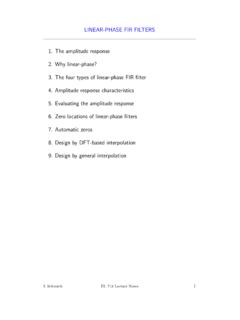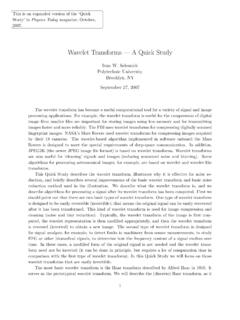Transcription of Exercises in Signals - New York University
1 Exercises in Signals , Systems, and TransformsIvan W. SelesnickLast edit: October 27, 2014 Contents1 Discrete-Time Signals and System More Z Inverse Di erence Complex Frequency Summary Simple System More Continuous-Time Signals and System Laplace Di erential Complex Frequency Simple System Fourier Fourier Fourier The Sampling Theorem15011 Discrete-Time Signals and an accurate sketch of each of the discrete-time Signals (a)x(n)=u(n+ 3) + (n 1)(b)x(n)= (n+ 3) + (n 1)(c)x(n)=2n (n 4)(d)x(n)=2n u( n 2)
2 (e)x(n)=( 1)nu( n 4).(f)x(n)=2 (n+ 4) (n 2) +u(n 3)(g)x(n)=1Xk=04 (n 3k 1)(h)x(n)=1Xk= 1( 1)k (n 3k) a sketch of each of the following Signals (a)x(n)=1Xk= 1( )|k| (n k)(b)x(n) = cos( n)u(n)(c)x(n)=u(n) 2u(n 4) +u(n 8) (n),x1(n),x2(n), andx3(n)wherex(n)=u(n+ 4) u(n),x1(n)=x(n 3),x2(n)=x(5 n),x3(n)=nXk= 1x(k) (n) andx1(n)wherex(n)=( )nu(n),x1(n)=nXk= 1x(k) (n) andx1(n)wherex(n)=n[ (n 5) + (n 3)],x1(n)=nXk= 1x(k) a sketch of each of the following Signals (a)f(n)=1Xk=0( )k (n 3k)(b)g(n)=1Xk= 1( )|k| (n 3k)(c)x(n) = cos( n)u(n)(d)x(n)
3 = cos( n)u(n) discrete-time Signals in plot the discrete-time impulse function:n = -10:10;f = (n == 0);stem(n,f)Usestemto plot the discrete-time step function:f = (n >= 0);stem(n,f)Make stem plots of the following Signals . Decide for yourself what the range ofnshould (n)=u(n) u(n 4)(1)g(n)=r(n) 2r(n 5) +r(n 10) wherer(n):=nu(n)(2)x(n)= (n) 2 (n 4)(3)y(n)=( )n(u(n) u(n 20))(4)v(n) = cos( n)u(n)(5) System discrete-time system may be classified as follows: memoryless/with memory causal/noncausal linear/nonlinear time-invariant/time-varying BIBO stable/unstableClassify each of the following discrete-times systems.
4 (a)y(n) = cos(x(n)).(b)y(n)=2n2x(n)+nx(n+ 1).(c)y(n) = max{x(n),x(n+ 1)}Note: the notation max{a,b}means for example; max{4,6}= 6.(d)y(n)= x(n)whennis evenx(n 1) whennis odd(e)y(n)=x(n)+2x(n 1) 3x(n 2).(f)y(n)=1Xk=0(1/2)kx(n k).That is,y(n)=x(n)+(1/2)x(n 1) + (1/4)x(n 2) + (g)y(n)=x(2n) discrete-time system is described by the following ruley(n)= (2n)+ (2n 1)wherexis the input signal, andythe output signal.(a)Sketch the output signal,y(n), produced by the 4-point input signal,x(n) illustrated (n)5(b)Sketch the output signal,y(n), produced by the 4-point input signal,x(n) illustrated (n)(c)Classify the system discrete-time system is described by the following ruley(n)=(x(n),whennis an even integer x(n),whennis an odd integerwherexis the input signal, andythe output signal.)
5 (a)Sketch the output signal,y(n), produced by the 5-point input signal,x(n) illustrated (n)(b)Classify the system discrete-time system is described by the following ruley(n)=( 1)nx(n)+2x(n 1)wherexis the input signal, andythe output signal.(a)Accurately sketch the output signal,y(n), produced by the input signalx(n) illustrated (n)(b)Classify the system the output of an LTI impulse response of a discrete-time LTI system ish(n)=2 (n)+3 (n 1) + (n 2).Find and sketch the output of this system when the input is the signalx(n)= (n)+3 (n 1) + 2 (n 2).
6 A discrete-time LTI system described by the ruley(n)=x(n 5) +12x(n 7).What is the impulse responseh(n) of this system? impulse response of a discrete-time LTI system ish(n)= (n)+2 (n 1) + (n 2).Sketch the output of this system when the input isx(n)=1Xk=0 (n 4k). impulse response of a discrete-time LTI system ish(n)=2 (n) (n 4).Find and sketch the output of this system when the input is the step functionx(n)=u(n). the discrete-time LTI system with impulse responseh(n)=nu(n).(a)Find and sketch the outputy(n)whentheinputx(n)isx(n)= (n) 2 (n 5) + (n 10).
7 (b)Classify the system as BIBO the output of an LTI impulse responseh(n) of an LTI system is given byh(n)= 23 nu(n).Find and sketch the outputy(n) when the input is given by(a)x(n)= (n)(b)x(n)= (n 2) the LTI system with impulse responseh(t) = cos ( t)u(n),find and sketch the step responses(t) and classify the system as BIBO the LTI system with impulse responseh(n)= (n 1).(a)Find and sketch the outputy(n)whentheinputx(n) is the impulse train with period 6,x(n)=1Xk= 1 (n 6k).(b)Classify the system as BIBO LTI system is described by the following equationy(n)=1Xk=0 13 kx(n k).
8 Sketch the impulse responseh(n) of this the parallel combination of two LTI (n)-h1(n)x(n)?6l+-y(n)You are told thath1(n)=u(n) 2u(n 1) +u(n 2).You observe that the step response of the total system iss(n)=2r(n) 3r(n 1) +r(n 2)wherer(n)=nu(n). Find and sketchh2(n). impulse response of a discrete-time LTI system is given byh(n)= 1ifnis a positive prime number0 otherwise (a)Is the system causal?(b)Is the system BIBO stable? observe an unknown LTI system and notice thatu(n) u(n 2)-S- (n 1) 14 (n 4)Sketch the step responses(n).
9 The step response is the system output when the input is the step functionu(n). an LTI system it is known that input signalx(n)= (n)+3 (n 1)produces the following output signal:y(n)= 12 nu(n).What is the output signal when the following input signal is applied to the system?x2(n)=2 (n 2) + 6 (n 3) More and sketch the convolutionx(n)=(f g)(n)where(a)f(n)=2 (n+ 10) + 2 (n 10)g(n)=3 (n+ 5) + 3 (n 5)10(b)f(n)= (n 4) (n 1)g(n)=2 (n 4) (n 1)(c)f(n)= (n+ 2) (n+ 1) (n)g(n)= (n)+ (n+ 1) + (n+ 2)(d)f(n)=4g(n)= (n)+2 (n 1) + (n 2).
10 (e)f(n)= (n)+ (n 1) + 2 (n 2)g(n)= (n 2) (n 3).(f)f(n)=( 1)ng(n)= (n)+ (n 1). impulse response of a discrete-time LTI system ish(n)=u(n) u(n 5).Sketch the output of this system when the input isx(n)=1Xk=0 (n 5k). signalfis given byf(n) = cos 2n .The signalgis (n)Sketch the signal,x(n), obtained by convolvingf(n) andg(n),x(n)=(f g)(n). signalsfandgare given byf(n)=2,g(n)= 12 nu(n).Sketch the signal,x(n), obtained by convolvingf(n) andg(n),x(n)=(f g)(n). signalsf(n) andg(n) are shown: 4 3 2 101234012312321f(n)n 4 3 2 101234 2 10123 12 1g(n)nSketch the convolutionx(n)=f(n) g(n).
















